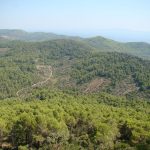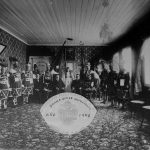Although merely 7 kilometers away from Korčula, Lumbarda has had quite a different history.
The first inhabitants that lived permanently at the location we call Lumbarda were the Illyrian tribes, ruling the island through the Bronze and Iron Ages, and what they’ve left around Lumbarda is numerous graves and other types of stone formations, mostly on the western sides of what’s known as Lumbarda today.
After that, we know that the Greeks had one of their two settlements in Lumbarda, which is proven by the most significant stone document from the antics ever found in Croatia, the so-called Lumbarda Psephisma, around a meter high document carved in stone, found in 1877 by Božo Kršinić, a Lumbarda local on the Koludrt hill, where many other archaeological findings were uncovered as well. Psephisma, which can be translated to English as “ordinance” is a document that describes in many details the establishment of the Greek colony on Korčula, founded by the Greeks leaving their colony on Issa, the island we call Vis today, based on the agreement with the already present Illyrian tribes, lead by their leader Pilo and son Daz. Lumbarda Psephisma was found near the top of the Koludrt hill, where the town of the Greeks from Issa was probably located, while their graveyard was located a bit to the south, where vases were found which are now being kept in Town Museum in Korčula. Just recently another sensational part of the Psephisma was found, adding to the understanding of the document!
The Illyrian inhabitants of Lumbarda were around until the Roman emperor Octavian occupied the entire island and that occupation was the end of Illyrian life on Korčula, and soon after that the first Roman families came to Korčula, a spacey 1st century villa was built for them in the Lumbarda Velo Poje, the field near the Bilin Žal beach. In addition to its size, it’s interesting in terms of building technique, as it is the only Roman villa on this side of the Adriatic build using that technique called “opus reticulatum”. Other significant Roman findings were unearthed on Koludrt and Sutivan, as well as on the islets of Sutvara, Vrnik and Kamenjak.
And then there’s a long period when it seems that no-one actually lived in Lumbarda, as there are no evidence of any inhabitation after the period of early Christianity, up until the Korčula Statute from 1214. And, to be honest, that mention of Lumbarda is not something to be proud of, as it bans any permanent inhabitation of Lumbarda, and even a fine for anyone who dares to spend the night there – there must’ve been a good reason for that! So, it’s quite understandable that the only buildings from that time are the two churches, both still standing today after being renovated several times – St. Barbara in Žabnjak and St. Ivan in already mentioned Sutivan.
In 1420 the island was occupied by the Venetian republic for a really long time, and that is when the permanent inhabitation of Lumbarda began anew. In the 16th century, it was already a fully formed settlement, with most houses built around the several churches. The oldest one of them is St. Roko on the Vela glavica, probably built in early 16th century, which became the seat of the Lumbarda parish, also formed in the 16th century.
In 17th and 18th century Lumbarda became the vacation destination for the rich and powerful people of Korčula (you have to forgive them for the 7 km trip to their vacation house; it was 400 years ago 😀 ), as the first mansion we know of was built in the 15th century, owned by the Diocese and located near Bilin Žal. Later many similar objects were erected, most in Tatinja and Prvi žal areas, and at the same time the castles imagined to serve the defensive purpose were built, and are still dominating the view.










